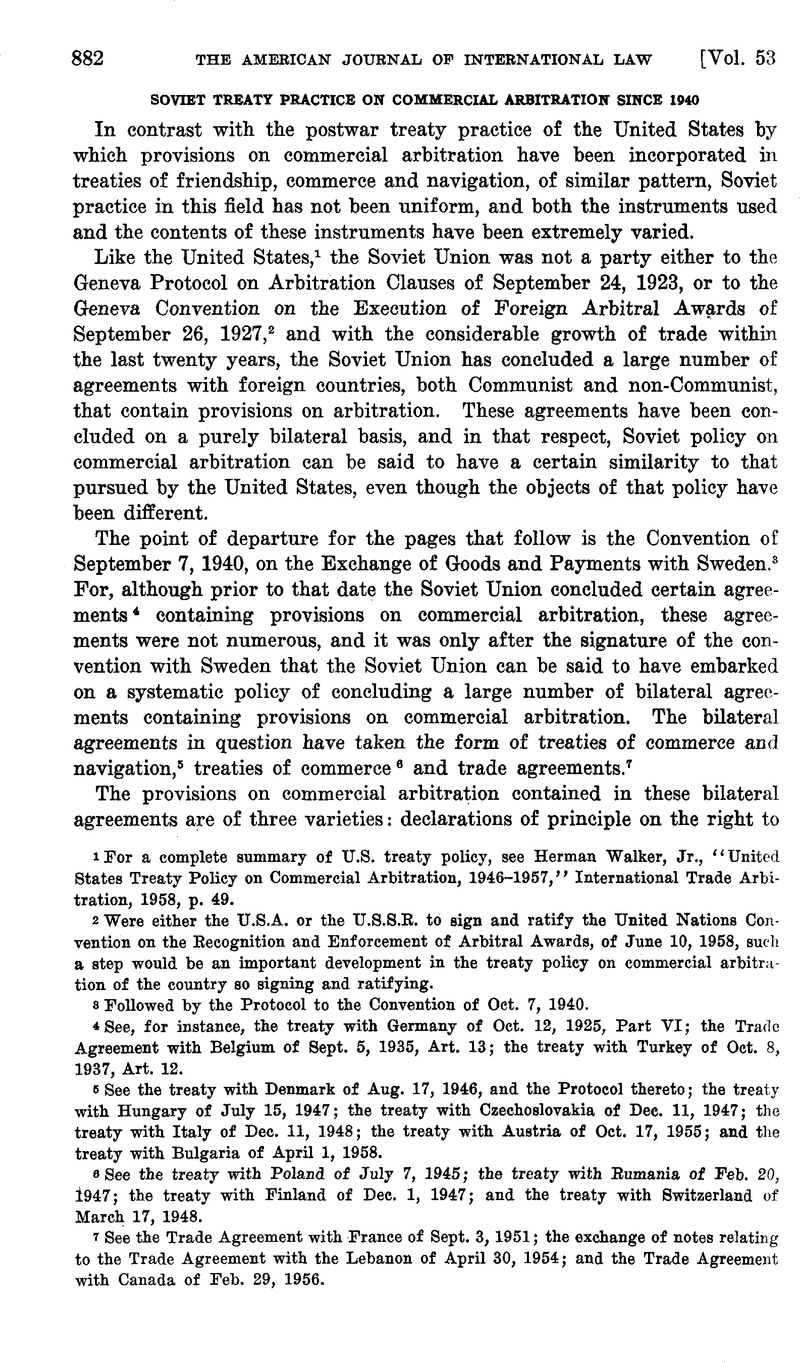Published online by Cambridge University Press: 28 March 2017

* The views expressed herein are the writer's personal views and should not be interpreted as those of the Organization.
1 For a complete summary of U.S. treaty policy, see Herman “Walker, Jr., ‘ ‘ United States Treaty Policy on Commercial Arbitration, 1946-1957,” International Trade Arbitration, 1958, p. 49.
2 Were either the U.S.A. or the U.S.S.R. to sign and ratify the United Nations Convention on the Recognition and Enforcement of Arbitral Awards, of June 10, 1958, such a step would be an important development in the treaty policy on commercial arbitration of the country so signing and ratifying.
3 Followed by the Protocol to the Convention of Oct. 7, 1940.
4 See, for instance, the treaty with Germany of Oct. 12, 1925, Part VI; the Trade Agreement with Belgium of Sept. 5, 1935, Art. 13; the treaty with Turkey of Oct. 8, 1937, Art. 12.
5 See the treaty with Denmark of Aug. 17, 1946, and the Protocol thereto; the treaty with Hungary of July 15, 1947; the treaty with Czechoslovakia of Dec. 11, 1947; the treaty with Italy of Dec. 11, 1948; the treaty with Austria of Oct. 17, 1955; and the treaty with Bulgaria of April 1, 1958.
6 See the treaty with Poland of July 7, 1945; the treaty with Rumania of Feb. 20, 1947; the treaty with Finland of Dec. 1, 1947; and the treaty with Switzerland of March 17, 1948.
7 See the Trade Agreement with France of Sept. 3, 1951; the exchange of notes relating to the Trade Agreement with the Lebanon of April 30, 1954; and the Trade Agreement with Canada of Feb. 29, 1956.
8 Art. 11. Under this article provision is made for the jurisdiction of courts of law in the absence of an agreement to arbitrate.
9 Art. 11. Under this article it is expressly stated that an agreement to arbitrate excludes recourse to courts of law for the purpose of settling the dispute.
10 Art. 4 of the Schedule to the treaty.
11 Arts. 14 and 15. The latter article contains provisions designed to avoid a conflict of jurisdiction in the absence of an agreement to arbitrate.
12 Art. 5 of the Schedule to the treaty.
13 Art. 4 of the Schedule to the treaty.
14 Art. 4 of the Schedule to the treaty.
15 The provisions of the protocol are examined in part 3 of this note.
16 The panel consists of five Danish and five Soviet nationals.
17 The protocol also has certain provisions as to the persons who may be present at the drawing of the lots, etc.
18 Another break in that tendency, insofar as the U.S.S.R. is concerned, will be found in the various protocols relating to general conditions of sale that have been concluded by the U.S.S.R. Ministry of Commerce with the Ministries of Commerce of various other countries in Eastern Europe. Under these protocols, provision is made for the holding of arbitrations in the defendant's country. See Korolenko, USSR Commercial Treaties and Conventions 194-195 (Moscow, 1953).
19 See Benjamin, Peter, “Inter-Institutional Agreements Designed to Extend Existing Facilities for International Commercial Arbitration,” 8 International and Comparative Law Quarterly 289 (1959).CrossRefGoogle Scholar
20 On this policy, see Andre1 Tunc, “Les aspects juridiques du commerce entre les pays d'économie planififie et les pays d'économie libre,” Revue Internationale de Droit comparé 1958, No. 2; John Hazard, “State Trading and Arbitration,” International Trade Arbitration 94.
21 On the procedure before the Foreign Trade Arbitration Commission of the U.S.S.R. Chamber of Commerce, see Peter Benjamin, “Apercu des institutions arbitrales de 1'Europe de l'Est qui exercent une activity dans le domaine de 1'arbitrage commercial international,” Revue de 1'Arbitrage, 1957, No. 4, p. 114, and 1958, No. 1, p. 2; see also Domke, “The Israeli-Soviet Oil Arbitration,” in this Journal, p. 787 above.
22 A second panel is also set up consisting of 4 members (similarly chosen from nationals of third countries) and constituting a reserve from which members of the first panel are replaced by the drawing of lots where death or incapacity prevents a member of the first panel from acting.
23 See Art. VII of the Convention, reprinted in 53 A.J.I.L. 420 (1959).
* The views expressed herein are the writer's personal views and shou